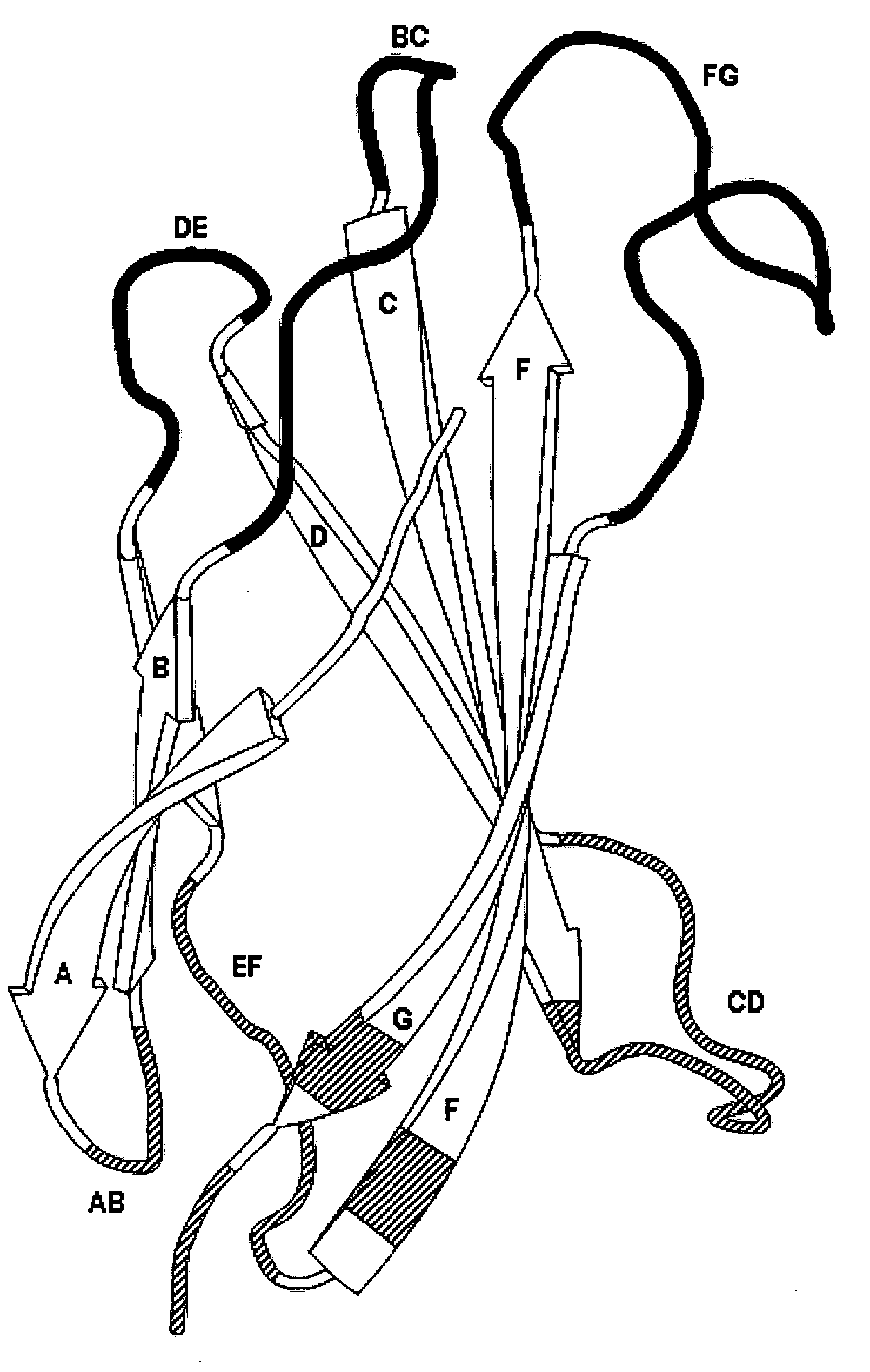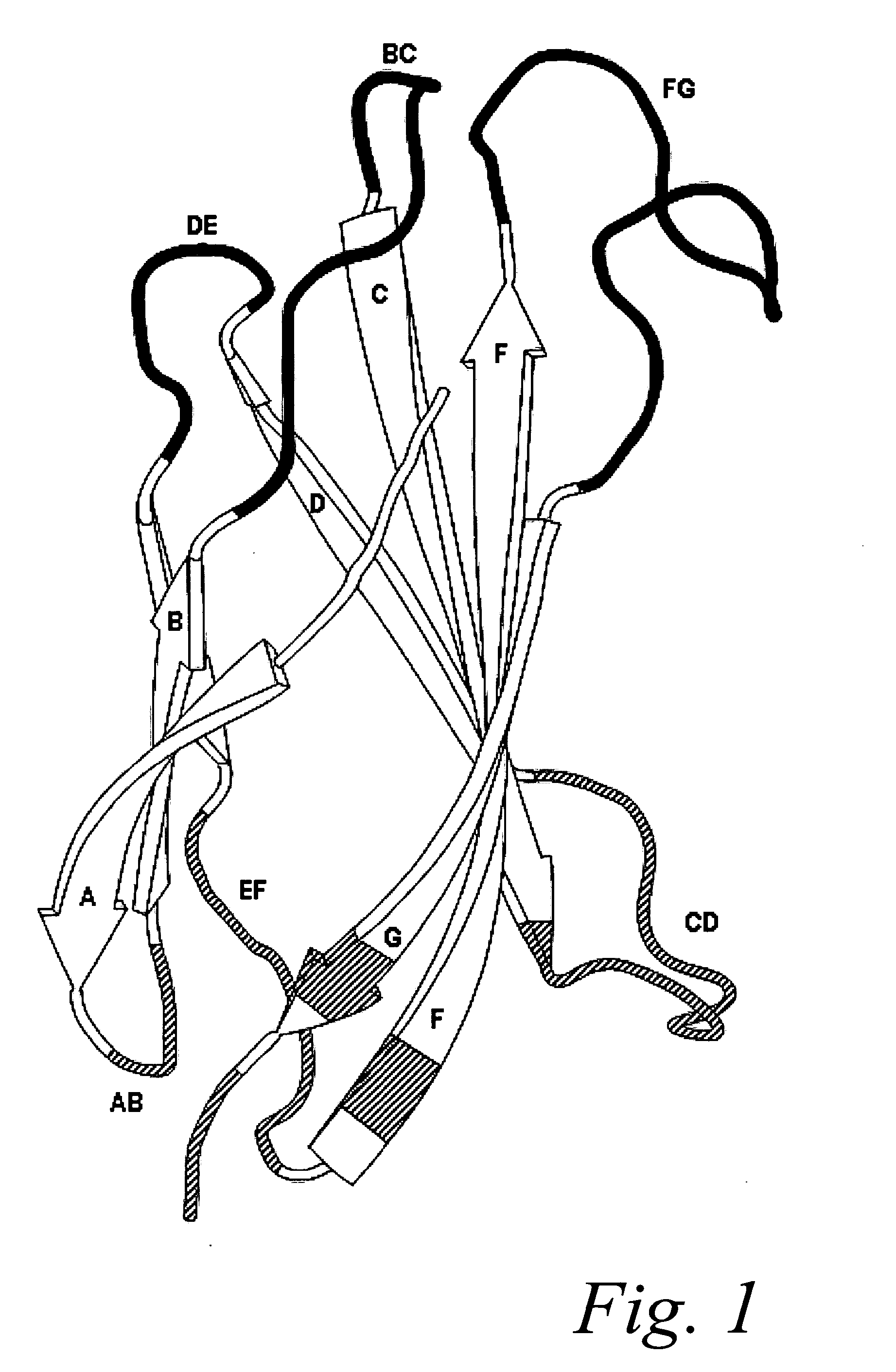Improved fibronectin-based binding molecules and uses thereof
- Summary
- Abstract
- Description
- Claims
- Application Information
AI Technical Summary
Benefits of technology
Problems solved by technology
Method used
Image
Examples
example 1
Production of Libraries of Fibronectin-Based Binding Molecules
[0167]In general, the practice of the present invention employs, unless otherwise indicated, conventional techniques of chemistry, molecular biology, recombinant DNA technology, immunology (especially, e.g., antibody technology), and standard techniques in polypeptide preparation. See, e.g., Sambrook, Fritsch and Maniatis, Molecular Cloning Cold Spring Harbor Laboratory Press (1989); Antibody Engineering Protocols (Methods in Molecular Biology), 510, Paul, S., Humana Pr (1996); Antibody Engineering: A Practical Approach (Practical Approach Series, 169), McCafferty, Ed., Irl Pr (1996); Antibodies: A Laboratory Manual, Harlow et al., C. S. H. L. Press, Pub. (1999); and Current Protocols in Molecular Biology, eds. Ausubel et al., John Wiley & Sons (1992). Other methods, techniques, and sequences suitable for use in carrying out the present invention are found in U.S. Pat. Nos. 7,153,661; 7,119,171; 7,078,490; 6,703,199; 6,67...
example 2
Screening of Monospecific Fibronectin-Based Binding Molecules
[0176]The present Example describes how to screen for fibronectin monospecific binders generated from the Libraries A and B described in Example 1. Both libraries A and B were independently subcloned into a yeast display vector such as pYD1 (Invitrogen) using homologous recombination methods and transformed into a suitable strain such as EBY100 using standard molecular biology techniques.
[0177]Presentation and selection of fibronectin based binders against hen egg lysozyme was conducted following essentially the protocol previously published by Lipovsek, D. et al, (J Mol Biol. 2007 May 11; 368(4):1024-41) with some minor modifications. Both libraries were independently screened for binders to hen egg white lysozyme.
(i) Selection for Binding to Hen Egg White Lysozyme Using Magnetic Bead Sorting
[0178]For all selections, yeast cultures presenting library A or library B of 10Fn3-based molecules were induced for 18 h at 30° C. ...
example 3
Generation of Bifunctional Fibronectin-Based Binding Molecules
[0186]Computer modeling of the randomized regions onto the x-ray structure of human Fn3 shows that by combining monospecific binders of each of the libraries A and B, one can create a bispecific fibronectin binding molecules. These binding molecules can be engineered such that they recognizes different regions on the same target molecule, or that the different binding sites of the bispecific or multispecific fibronectin molecule can bind to different regions on two or more different targets.
[0187]For example, a suitable sequence corresponding to binder A (obtained by screening Library A) and a suitable sequence corresponding to binder B (obtained by screening library B) can be combined into one single molecule to generate a bispecific molecule.
[0188]Binder A identified by screening library A (beta-sandwich with solvent exposed top loops BC, DE and FG).
(SEQ ID NO: 4)VSDVPRDLEVVAATPTSLLISWXXXXXXXRYYRITYGETGGNSPVQEFTVPXXXXTA...
PUM
 Login to View More
Login to View More Abstract
Description
Claims
Application Information
 Login to View More
Login to View More - R&D
- Intellectual Property
- Life Sciences
- Materials
- Tech Scout
- Unparalleled Data Quality
- Higher Quality Content
- 60% Fewer Hallucinations
Browse by: Latest US Patents, China's latest patents, Technical Efficacy Thesaurus, Application Domain, Technology Topic, Popular Technical Reports.
© 2025 PatSnap. All rights reserved.Legal|Privacy policy|Modern Slavery Act Transparency Statement|Sitemap|About US| Contact US: help@patsnap.com



